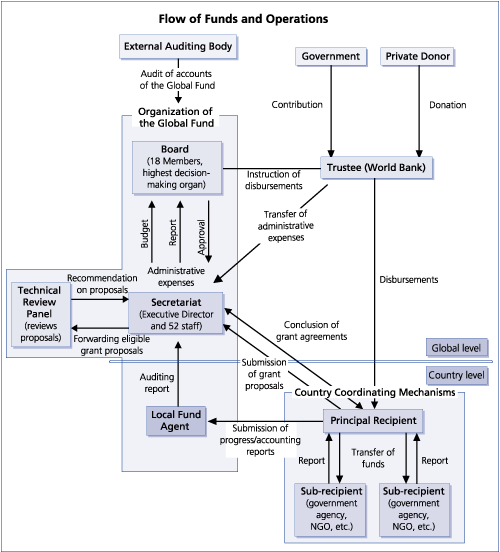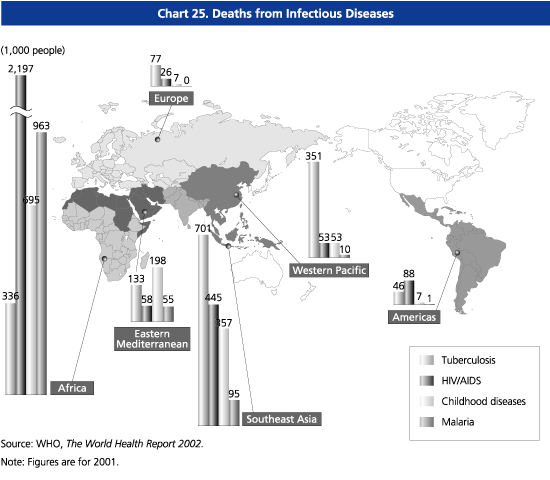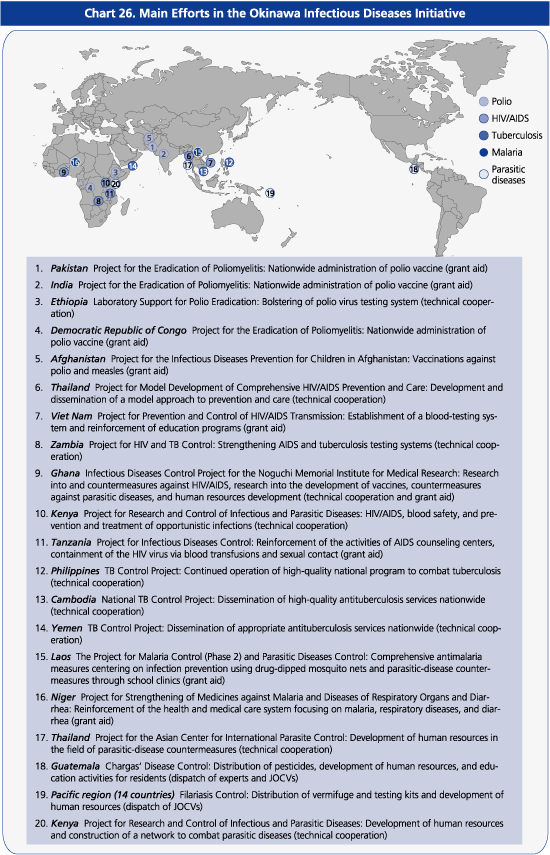Official Development Assistance (ODA)
Japan's ODA White Paper 2002
Part I. Trends in Japan's ODA in a Rapidly Changing World
Chapter 2, Section 5
(2) Strengthening Measures against HIV/AIDS and Other Infectious Diseases
Efforts by the International Community According to the World Health Organization (WHO) and other sources, approximately 60 million people have been infected by HIV/AIDS since it was first confirmed in the early 1980s, and around 3 million people die of the disease annually. Likewise, malaria, which is still epidemic in over 90 countries and regions, infects approximately 300 million new victims each year, and there are also 8 million new cases of tuberculosis each year, making it the leading cause of death among adults in developing countries. These diseases are not only a matter of health for individuals but also pose a political, economic, and social threat to the international community. Moreover, as globalization is increasingly facilitating the movement of people, developed countries can no longer afford to ignore the issues of infectious diseases plaguing developing countries.
The need for the Global Fund to Fight AIDS, Tuberculosis, and Malaria was highlighted at the UN General Assembly Special Session on HIV/AIDS in 2001. The Global Fund was created in January 2002 after G8 member countries agreed at the 2001 Genoa Summit to establish a fund based on government and private-sector contributions. The Global Fund receives technical support from the World Health Organization (WHO) and the Joint UN Program on HIV/AIDS (UNAIDS) while having the status of an independent non-profit foundation under Swiss law with its headquarters in Geneva. In recognition of its contributions in the fight against infectious diseases, Japan holds the position of Vice Chair of the Global Fund's Board. During a visit to the United States in June 2001, Prime Minister Junichiro Koizumi announced Japan's intention to contribute $200 million to the Global Fund.
At the second Board meeting in April 2002, the Board approved 58 proposals in 40 countries for the first round of project funding totaling $616 million over two years. The Global Fund and recipient countries are concluding grant agreements for the disbursement of funds.

Japan took the lead in stressing the importance of infectious diseases at the G8 Kyushu-Okinawa Summit in 2000. This focus continued into 2001 at the UN General Assembly Special Session on HIV/AIDS and at the G8 Genoa Summit, leading to the establishment of the Global Fund to Fight AIDS, Tuberculosis, and Malaria (GFATM) on January 1, 2002. The GFATM is expected to play a central role in global efforts against infectious diseases. At its second meeting in April 2002, the GFATM Board approved its first aid package of $616 million for 58 projects in 40 countries. Japan also supports initiatives to combat HIV/AIDS and other infectious diseases through international organizations like the WHO and the Joint UN Programme on HIV/AIDS (UNAIDS).
Okinawa Infectious Diseases Initiative In 1994 Japan announced the Global Issues Initiative on Population and AIDS (GII), pledging $3 billion in assistance over a seven-year period. The actual amount provided reached $5 billion, far exceeding the initial target, enabling Japan to play a leading role in measures against infectious diseases. Moreover, Japan enhanced its efforts with the Okinawa Infectious Diseases Initiative (IDI), a comprehensive strategy against infectious diseases announced at the Kyushu-Okinawa Summit as a continuation of the GII to contribute $3 billion over the next five years. The basic philosophy behind the IDI is that (1) countermeasures against infectious diseases are a core development issue; (2) the response must be based on global partnership and community-based action; and (3) Japan's experiences of fighting against infectious diseases associated with public health activities should be utilized. As of March 2002 Japan had implemented approximately $1.8 billion in aid under the IDI.
Japan is also working in collaboration with the international community. In June 2002, Japan and the United States jointly announced the USAID-Japan Partnership for Global Health. (See Box 26).
Expansion of Regional Efforts on Infectious Disease There are considerable regional differences in the situation regarding infectious diseases, so regional efforts should be based on close dialogue with a broad range of partners, including recipient countries.
Regarding Asia, which has a great impact on Japan, at a November 2001 meeting of the leaders of the Association of Southeast Asian Nations plus China, Japan, and Korea (ASEAN+3), Japan announced the Japan-ASEAN Information and Human Network for Infectious Diseases Control13 targeting HIV/AIDS, tuberculosis, malaria, and parasitic diseases. Japan will utilize this network, using facilities that have been supported by Japan as centers, to strengthen measures against infectious diseases in the ASEAN region.
Meanwhile, over 70% of the people infected with HIV/AIDS, or 29 million people, are concentrated in Africa. Deaths from HIV/AIDS have dramatically reduced life expectancies in some countries, threatening their social fabric, and so the international community must act urgently on this issue. Japan has given priority to HIV/AIDS in its assistance to Africa, such as by organizing a workshop in Zambia in March 2002 on measures against HIV/AIDS in southern Africa. Although Japan's efforts currently take place mainly in southern Africa, similar efforts are expected for eastern and western Africa as well.
Utilizing Japan's Experience After World War II, Japan dealt successfully with infectious and parasitic diseases by linking such efforts with public health activities like the establishment of a system of public health centers, training of public health workers, promotion of maternal and child health, and enhanced healthcare services in schools. Japan has been utilizing such experience when implementing ODA. For example, MCH (Maternal and Child Health) Handbooks were highly effective in promoting maternal and child health in postwar Japan. This experience was introduced in Indonesia as a pilot project, and MCH Handbooks are now being used in many provinces there. Furthermore, measures to combat parasitic diseases, which could also have other tangible benefits for residents, such as improvements in nutrition, were pursued in Japan nationwide, which eventually led to the spread of the notion of hygiene and the improvement of the environment. That experience is now being applied in Asia, Africa, and Latin America.
In Nepal, Thailand, and elsewhere, Japan's knowledge in school healthcare is being used in projects to utilize schools in expanding health countermeasures against infectious diseases and in improving nutrition, from child to child, children to adults, and to the community. To ensure the effectiveness of these projects, the government is working in collaboration with organizations that have human resources and knowledge regarding Japan's postwar efforts to combat tuberculosis and improve maternal and child health, such as the Japan Anti-Tuberculosis Association's Research Institute of Tuberculosis and the Japanese Organization for International Cooperation in Family Planning.
13. Prime Minister Junichiro Koizumi proposed the Japan-ASEAN Information and Human Network for Infectious Diseases Control at a Japan-ASEAN summit meeting in 2001. Its aims are to develop human resources and build capacity in ASEAN countries for measures against infectious diseases, especially HIV/AIDS, tuberculosis, and malaria; to build a human network within ASEAN centered on the public health facilities supported by Japan; and to utilize the network to promote South-South cooperation.


